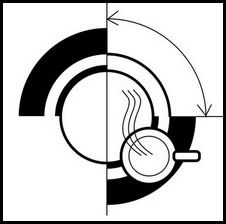
A little earlier today I was watching Giada and the episode was Pizza Party. Hmmm. We haven't had pizza in a while and tomorrow seems like a fine time to have some. Plus that Arugula, Ricotta and Smoked Mozzarella Pizza she made looked pretty good. May use that as a starting point for tomorrow's meal after we make our dough.
Fact of life: Pizza always tastes better with homemade dough.

This is a recipe my friend Pepper shared some years ago and I'm so glad she did. Her comment was, "This one is the best I've found. I usually triple the recipe and throw the leftovers in the freezer for later use." I really like it too, and the recipe can be found many places online as well as in The California Pizza Kitchen Cookbook. Normally I double the recipe and also freeze some for later use. If freezing, I like to put it in the refrigerator to thaw at least a day before I want to bake pizza.
No photos as I just put the ingredients in the breadmaker. Those will come when I'm making the pizza tomorrow. The recipe includes instructions for making the dough by hand, in a stand mixer, and in the food processor. I added the breadmaker directions in my notes at the bottom of the recipe.
| California Pizza Kitchen Basic Pizza Dough Makes dough for (2) 9" pizzas 1 tsp yeast ½ cup, plus 1 Tbsp warm water (105°-110°F) 1½ cups bread flour or all-purpose flour 2 tsp sugar 1 tsp salt 1 Tbsp extra virgin olive oil, plus 1 tsp for coating To make the dough 1. Dissolve the yeast in the water and set aside for 5 to 10 minutes. Be sure that the water is not hot; temperatures of 120 degrees F and above will kill the yeast, and your dough will not rise. 2. If using an upright electric mixer, such as a KitchenAid, use the mixing paddle attachment because the batch size is too small for the dough hook to be effective. Combine all other ingredients (except the additional teaspoon olive oil) and combine them with the dissolved yeast in the mixing bowl. (Do not pour the salt directly into the yeast water because this would kill some of the yeast.) Allow these two ingredients to mix gradually; use the lowest 2 speeds to mix the dough. Mix for 2 to 3 minutes, until the dough is smooth and elastic. Overmixing will produce tough, rubbery dough, and friction will cause the dough to rise too fast. 3. If using a food processor, use a dough "blade" made of plastic rather than the sharp steel knife attachment, which would cut the gluten strands and ruin the consistency of the dough. Otherwise, proceed as above. Be especially cautious not to mix too long with a food processor because the temperature resulting from the friction of mixing could easily exceed 120°F, killing your yeast. Mix only until a smooth dough ball is formed. 4. If mixing by hand, place the dry ingredients in a 4 to 6 quart mixing bowl; make a well in the middle and pour in the liquids (reserving the teaspoon of olive oil). Use a wooden spoon to combine the ingredients. Once initial mixing is done, you can lightly oil your hands and begin kneading the dough; knead for 5 minutes. When done the dough should be slightly tacky (that is, it should be barely beyond sticking to your hands). 5. Lightly oil the dough ball and the interior of a 1-quart glass bowl. Place the dough ball in the bowl and seal the bowl with clear food wrap; seal airtight. Set aside at room temperature (70-80° F) to rise until double in bulk - about 1½ to 2 hours. 6. (The dough could be used at this point, but it will not be that wonderful, chewy, flavorful dough that it will later become.) Punch down the dough, re-form a nice round ball and return it to the same bowl; cover again with clear food wrap. Place the bowl in the refrigerator overnight, covered airtight. 7. About 2 hours before you are ready to assemble your pizza, remove the dough from the refrigerator. Use a sharp knife to divide the dough into 2 equal portions (or 4 equal portions if making appetizer-sized pizza or if smaller 6-inch pizzas are desired). Roll the smaller doughs into round balls on a smooth, clean surface; be sure to seal any holes by pinching or rolling. 8. Place the newly formed dough balls in a glass casserole dish, spaced far enough apart to allow for each to double in size. Seal the top of the dish airtight with clear food wrap. Set aside at room temperature until the dough balls have doubled in size (about 2 hours). They should be smooth and puffy. To stretch and form the dough for pizza Preheat the oven to 450°F. Place a pizza stone on the middle rack of the oven. Use a metal spatula or dough scraper to remove a dough ball from the glass casserole dish, being as careful as possible to preserve its round shape. Flour the dough liberally. Option 1: Sprinkle a medium dusting of flour over a 12×12" clean, smooth surface. Place the floured dough on the floured smooth surface. Use your hand or rolling pin to press the dough down forming a flat circle about ½" thick. Pinch the dough between your fingers all around the edge of the circle, forming a lip or rim that rises about ¼" above the center surface of the dough. You may continue this outward stretching motion of the hands until you have reached a 9" diameter pizza dough. Top as desired and bake. Option 2: Lightly oil pizza pans, and dust with semolina or cornmeal. Place the dough on the pizza pan. With your fingers, press out into a circle, forming a slightly thicker raised rim around edge of the circle. Brush everything but the rim with a little olive oil, then top the pizza with the toppings of your choice and bake on pizza stone. Notes: 1. I like to use my breadmaker to mix and first rise the dough. To do that, I double the amounts of the ingredients. Place in breadmaker in this order: warm water, sugar, salt, olive oil, flour and yeast. Set mode to make dough and Start. When the cycle is finished, proceed from Step 6, lightly oiling the dough with the remaining olive oil before placing it in the bowl in the refrigerator. 2. Sometimes I substitute some whole wheat flour for part of the all purpose flour. Usually about one cup in the doubled recipe. |
namasté,
















 Alabama Time
Alabama Time Paris Time
Paris Time Venice Time
Venice Time










No comments:
Post a Comment